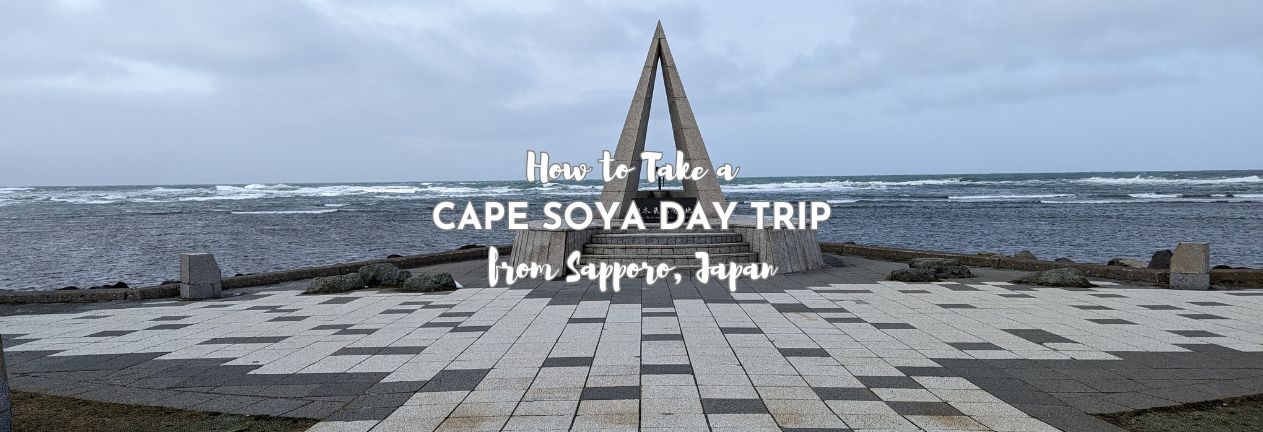Some days, you just want an adventure for the sake of an adventure, and the fact that we had a JR Pass meant that we could do lots of adventuring. Just for the sake of it. Today’s adventure was to take a day trip to Japan’s most northerly point, Cape Soya, just because we could. It would mean traveling for perhaps 15 hours to spend 45 minutes at Cape Soya. And as the travel options are limited, it meant we had to make the connections, or spend the night in Japan’s north. Here’s our guide to taking a day trip to Cape Soya. It is great fun!
THIS POST MAY CONTAIN COMPENSATED AND AFFILIATE LINKS MORE INFORMATION IN OUR DISCLAIMER
One of the key points of having a JR Pass is to make sure that you get your use out of it. And this trip was in part about that, but also about the adventure of going to explore the most northerly point of Japan. There’s not a huge amount there, but on a clear day, you can see Sakhalin Island, an island on the eastern edges of Russia. You don’t need a JR Pass to do this route; you can simply buy a ticket for the train here. you can drive, take flights, or get transfers.
PRACTICAL TRAVEL TIPS
- 🛡️ Get Travel Insurance: Civitatis includes medical expenses, repatriation, theft, luggage delays. No deductibles or upfront payments. Get a quote here.
- 💰 Read about the Currency in Japan and ATM fees.
- 🔌 Check out Japan’s plug, socket & power situation.
- 📶 Internet, maps, and data on the go. eSims for Japan
Where is Cape Soya?
Cape Soya is in Hokkaido, and therefore Japan’s most northerly point. You’ll find it around 30 kilometers (19 miles) from Wakkanai. There’s a bus stop here, monuments, and a view of that island, Sakhalin, now part of Russian Territory, but it used to be Japanese.
Why go to Cape Soya?
I mean, shouldn’t the question be why not? There’s something special about going to the “ends of the earth”, the most northerly point, the most southerly point, and all that. We started this trip to Japan in Okinawa and worked our way up through the islands, so it felt fated that we would add Cape Soya to our Japan Itinerary.
In the main, most people come to Cape Soya because they can. To see if they can spot Sakhalin Island, to eat the soup curry that you’ll get here, as a staple of Hokkaido, or to just see another part of Japan.
How to Get to Cape Soya
You’ll need to get as far north as Sapporo to visit Cape Soya, whether that’s a flight or a series of trains. And from there you’ll then need to head further north to Wakkanai, home of Japan Rail’s most northerly railway station, and also Japan’s most northerly city. We’re hitting a few miles stones there, eh?
There are several route options.
- Sapporo to Wakkanai by train, then bus to Cape Soya
- Drive from Sapporo to Wakkanai to Cape Soya
- Fly from Sapporo to Wakkanai, then take the bus to Cape Soy
Of course, instead of taking the bus from Wakkanai to Cape Soya, you can also take a taxi and have it wait for you. But where’s the fun in that?
I wrote a guide about the different ways to go from Sapporo to Wakkanai, with all the details here, but for inclusion here, here are the highlights.
Train from Sapporo to Wakkanai, bus to Cape Soya.
This is the route that we took, and I’d recommend it if you have the time. It’s a long day. There is one train a day that comes from Sapporo to Wakkanai. If you don’t catch this train then the trip is off.
Train from Sapporo to Wakkanai
There is one train a day to Wakkanai from Sapporo. It leaves at about 07:30 from Sapporo. Buy the ticket here. You will need to catch the train from Wakkanai back to Sapporo at 17:30-17:45. The timetables vary slightly, but those are the timeframes that you’re working with. It makes for a long day, but it’s great fun. And of course, someone else is driving, so you can snooze, read, or just watch northern Hokkaido go by outside the windows.
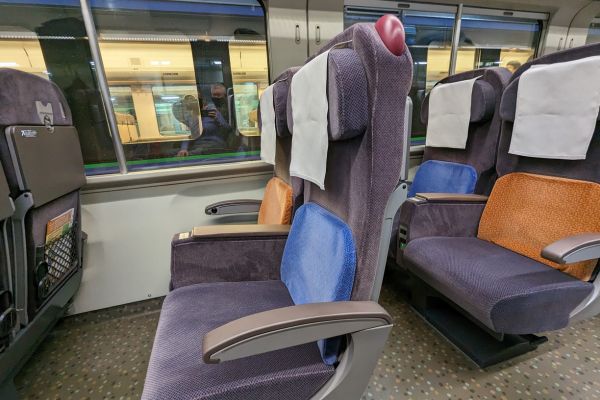
The train you’re catching is the Soya. It’s a JR Hokkaido limited express service and runs one service a day between Sapporo and Wakkani. It is covered on the JR Pass.
OPTION #1 BUY THE CHEAPEST JR PASS
Buy Japan Rail Pass from Klook
- Includes Worldwide Shipping
- Buy Regular or Business Class Pass
- Buy 7 day, 14 day or 21 day Japan Rail Passes
The name of the train, also the name of the cape that we were heading to, comes from the indigenous Ainu language and is a place name. This whole area is the Soya subprefecture, and the train line is the Soya mainline.
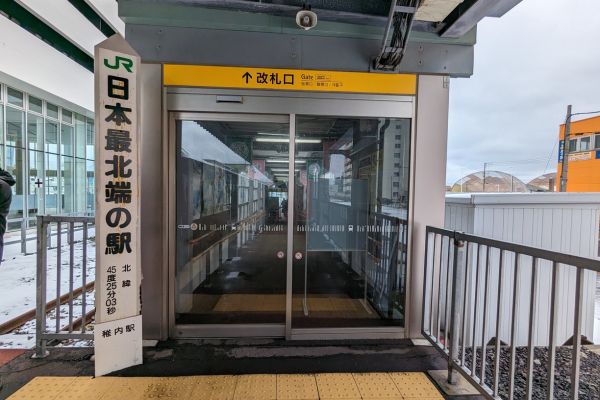
The train arrives at JR Wakkanai at 12:40 (ish, depending on the timetable). You’ll be back here after visiting Cape Soya, with plenty of time to take the relevant photos of the drain covers, signs of Japan’s most northerly train station, and all that, and even explore a little more of Wakkanai itself. First, let’s get the bus to Cape Soya.
Bus from Wakkanai to Cape Soya
The bus that goes to Cape Soya from Wakkanai stops conveniently right outside Japan’s most northerly train station, JR Wakkanai. The station is comfortable with lots of seating, several coffee stops, and places to get something to eat, and importantly, is co-located with the Wakkanai Information Center.
Pop into the information center and buy your return bus tickets from there, and take a photo of the bus timetable, or they will point you to the bus stop. You’re aiming for the Tenpoku Soya Misaki Line, heading towards Hamatombetsu or Onishibetsu.
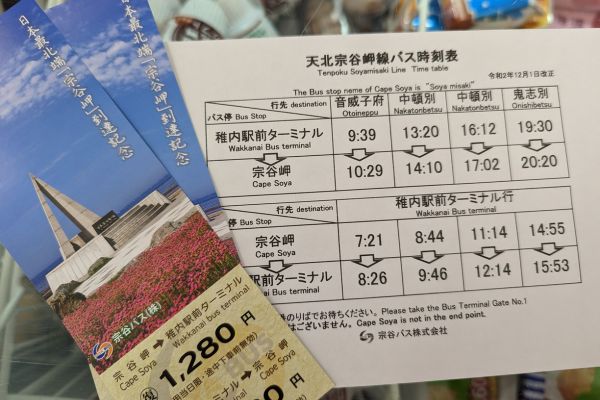
The bus ticket from Wakkanai JR Station to Cape Soya (Soya Misaki) is ¥1,600 one way or ¥2,880 for the return trip. Buy your ticket inside the information center. If you’re taking the train up from Sapporo and doing this as a day trip, then you have ONE option for this bus. You’ll need to be on the bus that leaves Wakkanai at 13:20. And you have one return bus that will take you back to Wakkanai to be able to catch the return train to Sapporo. You can see the return details below.
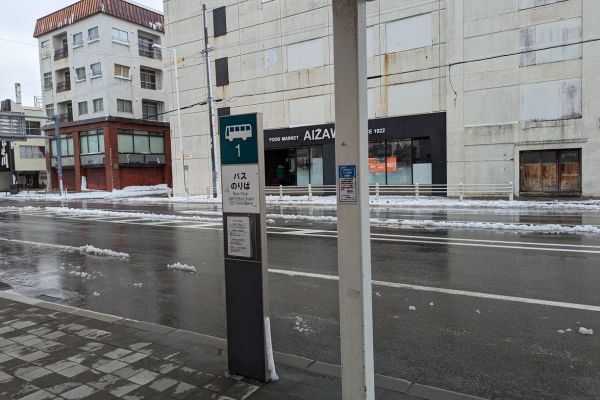
It is 30 kilometers (19 miles) from this point in Wakkanai, up route 238 to Cape Soya. The bus takes about 450 minutes. The information center can help you with a taxi if you prefer not to take the bus. The bus goes from stop/platform 1.
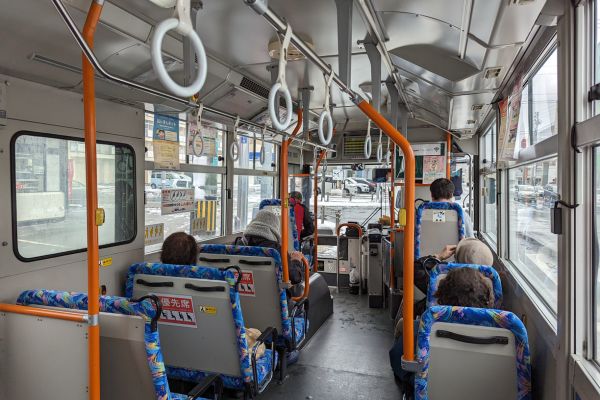
The stop that you want to get off at for Cape Soya is NOT the end of the line, but I guess that most people who are on the bus (there were about 6 of us) will be getting off at Cape Soya. The name of the bus stop is Soya Misaki. You can find the current timetable here.
And here’s a copy of the timetable that the nice folks in the information center gave us.
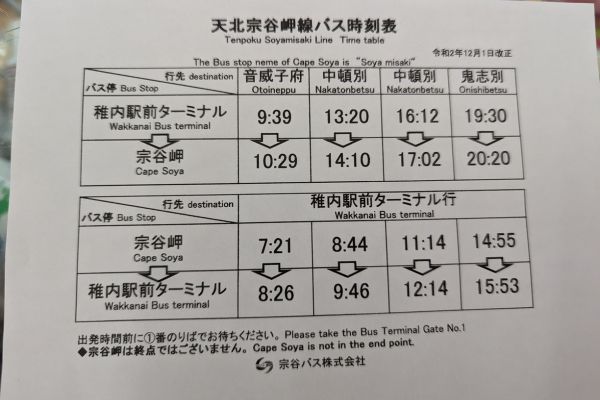
What to see at Cape Soya
We had a list of things to see at Cape Soya. Of course, we did. We always have a list. First off, we kept an eye on our watches, as we had to catch the bus back, to catch our train back, and this place, in mid-April, doesn’t feel like you’ll find cruising taxis just looking for business.
Our bus arrived on time at 14:10, which gave us, looking at the timetable, 45 minutes to explore Cape Soya before we needed to be on the bus again at 14:55.
It was COLD. The wind blowing off Russia was icy. 45 minutes was going to be long enough, but you need to hustle! At least it was fine, and there were some spots of sun too. Wear layers…bring gloves. And your camera!
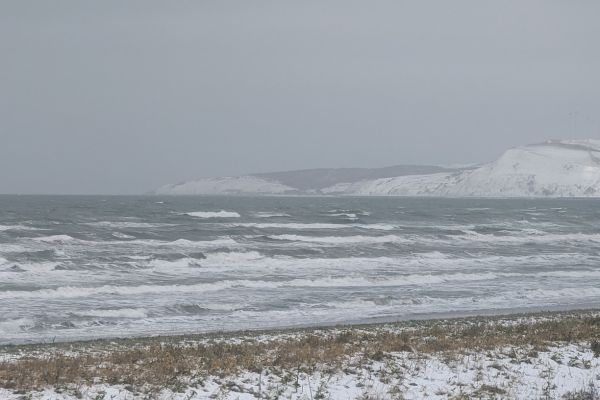
The first things to see are close to the water, and there are three things to see. And one potential museum, if you have longer, if it’s open. The other things to see here are across the road and up the small hill.
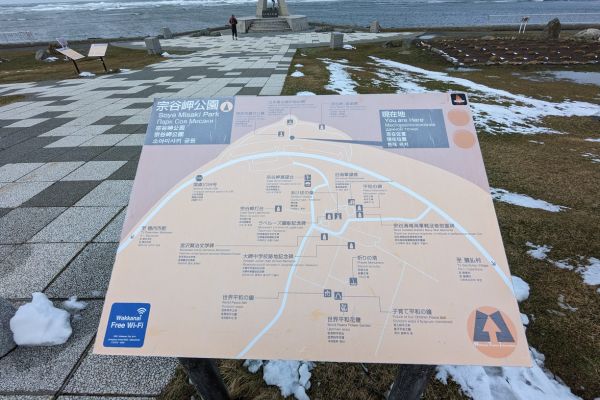
The Monument of the Northernmost Land of Japan. (日本最北端の地の碑)
Cape Soya is at a northerly latitude of 45 degrees, and so there’s a monument here declaring that. The triangular stone monument is located at 45 degrees, 31 minutes, 22 seconds north. You’ll find the letter N at its center, indicating north.
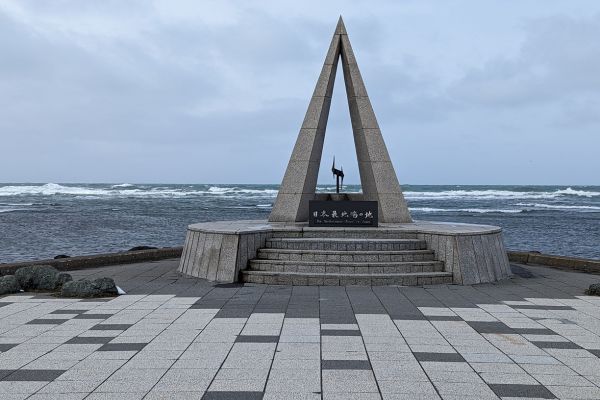
Statue of Mamiya Rinzo, the Japanese Explorer
Most famous for charting unexplored areas of Northeast Asia, Mamiya Rinzo (1775 – 1844) is memorialised here in a bronze statue. His most famous expedition led to the discovery of Karafuto, which is now Sakhalin Island, that you might be able to see in the distance, if the weather is clear. He explored Karafuto twice and discovered the Mamiya Strait, aka the Tatar Strait, in 1809.
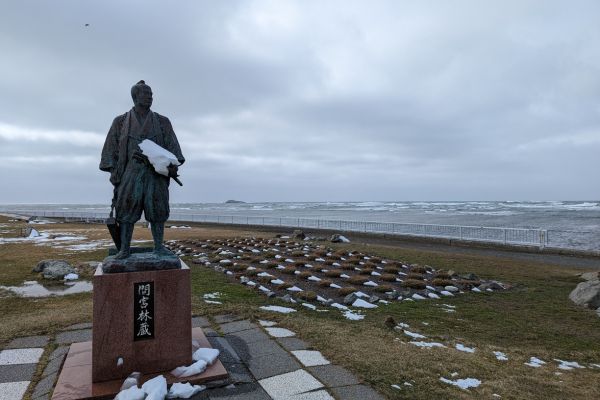
The 1976 Soya Misaki Musical Monument
This musical monument is dedicated to, and plays a hit from 1976, called “Soya Misaki,”. You’ll need to press the button on the stainless steel column to hear it (wind permitting). It’s written about the cape and is in “Enka” style, which is a type of sentimental ballad.
The monument details the musical score and lyrics of the song that was written about springtime here. The lyrics were written by the local songwriter, Yoshida Hiroshi, and the music was composed by Funamura Toru, a famous Enka composer. While it was released in 1972, it didn’t become a hit until 1976 when it appeared on a TV music program.
The Cape Soya Drift Ice Museum & Souvenir Shop
The blue building with a triangular appendage to the roof is the Cape Soya Drift Ice Museum. It wasn’t open when we visited, but with just 45 minutes to explore the area, that’s perhaps just as well. It purports to be open all summer, so perhaps if you visit, you’ll let me know what it was like.
The most northerly public toilets in Japan
They’re free, and this is Japan, so they’re clean and you should use the facilities while you are here!
The Peace Park at Cape Soya, aka the Cape of Monuments Park
The other monuments that you’ll want to see here are across the road and up the small hill. You’ll get a better view of potential sightings of Sakhalin Island from here, and the wind will be stronger, too. There’s an old naval watchtower up here, the Cape Soya Lookout, various memorials and monuments.
What you’ll find useful for exploring the whole area are the printed maps that are displayed on signboards around the area, noting the location of the various monuments and statues. They’re in English, Japanese, Chinese, and Russian.
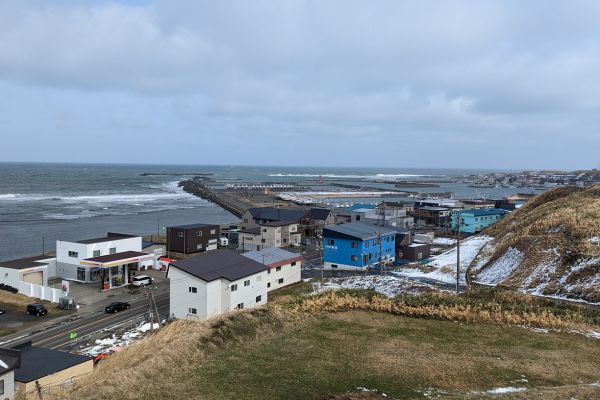
I’ve detailed the various monuments. And I know that you’re thinking that 45 minutes isn’t enough time to get around all of these. Trust me, it is. Read about them beforehand, and then head up here, take your photos, enjoy the view, and you’ll be back in time for the bus back to Wakkanai, but remember to keep an eye on your watch!
Directional and Mileage Signpost
As is the norm, you’ll also see the signpost telling the details of how far it is to various Japanese cities, and of course, Sakhalin Island, which stands just 43 kilometers distant, while the capital of Japan, Tokyo, is 1108 kilometers away!
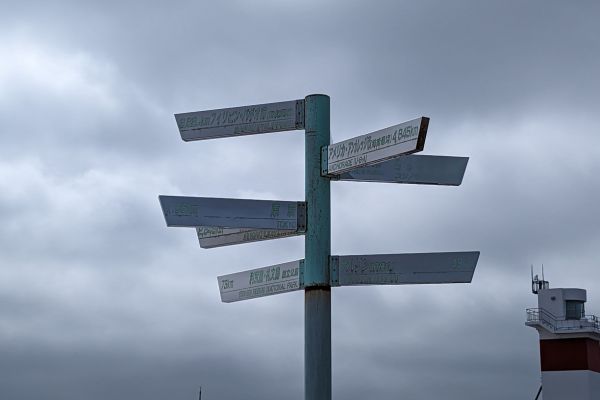
Former Naval Watchtower
It was in 1875 that Japan exchanged Karafuto, now Sakhalin Island, for the Kuril Islands. Up until this point, both the Japanese and Russians lived on the islands. After the treaty of 1875 was signed, Wakkanai became a border city, and the watch tower was built in, although not until 1902. It was designed to observe the movement of the Russian Navy.
It’s a two-story building, and you can go up to the second floor and look through a window, and get a great view of the Soya Strait.
Akebono Statue
The bronze statue that’s named Akebono – meaning “dawn, daybreak or the beginning” –symbolises the dawn of dairy farming in this area. This area isn’t suitable for growing rice because of the climate, and most of the farms here focus on dairy cattle. The statue shows a young couple, wearing farm clothes, looking over the area. It was built to commemorate the number of dairy cattle reaching 500,000 in Hokkaido, and milk production hitting more than a million tons!
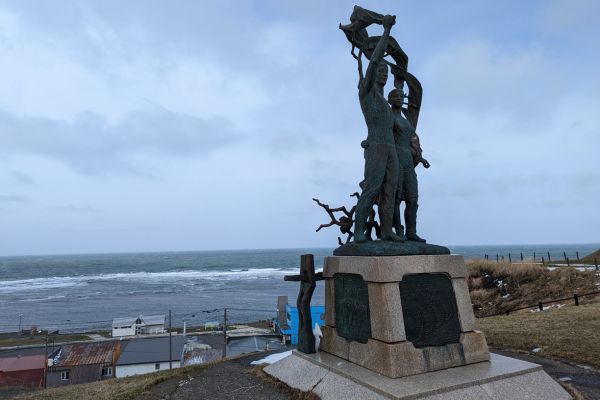
Cape Soya Lighthouse
The Cape Soya lighthouse was built in 1885, and this red and white striped lighthouse is the most northerly in Japan and was the third to be built in Hokkaido. It is 17 meters tall.
Monument in Honour of La Perouse
The French Naval office, Count La Perouse, led an expedition of two frigates through the waters of Northern Hokkaido in 1785 on the orders of King Louise XVI of France. It was he who discovered the strait between Hokkaido and the now Sakhalin Island in 1787. The strait was named in his honour, and this monument was erected in 2007, some 220 years after the discovery.
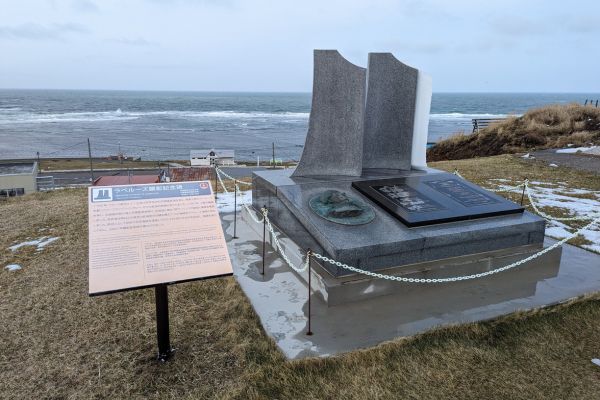
Soya Coastal Waters Navy War Memorial
This memorial is dedicated to the Japanese Navy vessel, with 152 sailors onboard, that protected the cargo ferry, the Soya Maru, and was sunk as a result. It was in 1945 that the cargo ferry, the Soya Maru, was servicing Sakhalin/Karafuto when it came under attack from an American submarine. The Japanese vessel manoeuvred and protected the ferry, and was sunk with the loss of all hands.
Peace Memorial
During World War II, the Soya Strait was the scene of a battle between the Americans and the Japanese. The USS Wahoo was sunk here in the La Perouse Strait on 11 October 1943. Under the command of Lieutenant Commander Dudley Walker “Mush” Morton, the sub was sunk with all 79 hands after an air and surface attack from the Imperial Japanese Navy. Before being sunk, the Wahoo had sunk five Japanese merchant ships. The memorial was jointly erected by Japan and the United States in 1995 to commemorate those who died on the USS Wahoo and the 696 crew members of the merchant ships that the Wahoo sank.
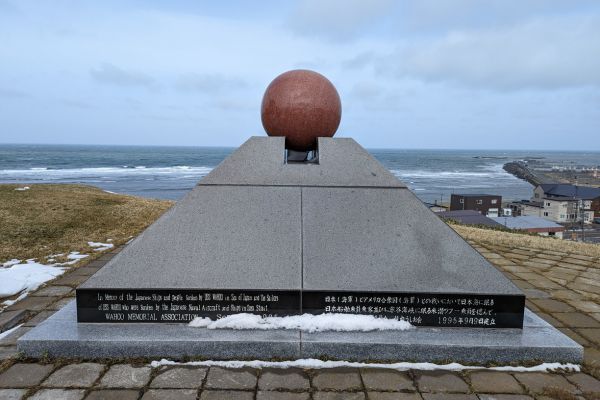
World Peace Bell
The World Peace Bell here was cast in 1988 using coins and medals donated by individuals in 81 different nations. It echoes the first World Peace Bell, made in 1954 here in Japan, which was cast from copper and coins from the 65 United Nations member states. That bell was designed to draw attention to the abolition of nuclear weapons and the tragedies of war. You can ring the bell and wish for peace.
Omisaki Junior High School Memorial
This memorial remembers the junior high school that was once here.
Miyazawa Kanji Literature Monument
The Japanese poet, novelist, and children’s literature writer (1896 – 1933) visited the area, traveling to Sakhalin by ferry from Wakkanai in 1923. The poem that’s memorialised here is said to have been recited on board.
The Tower of Prayer Monument
On September 1st, 1983, the Korean Air Flight KE007 from New York to Seoul flew off course and entered Russian Airspace above Sakhalin Island. Scrambled Russian Sukhoi Su-15 jets fired missiles at the airliner, and it crashed into Moneron Bay, to the west os Sakhalin Island. All 269 passengers and crew were lost.
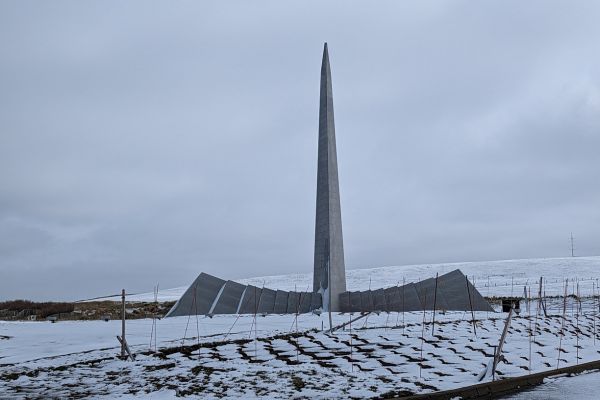
As the closest city to the scene of the disaster, it fell to Wakkanai to host investigators and news reporters. This monument, designed to look like a paper crane, was built two years after the disaster by relatives and friends of the victims. The monument is 19.83 meters high, depicting the year of the disaster. It has 16 wings, which reflect the countries of the victims, and the 269 white granite stones represent the victims. The beak of the crane points in the direction of where the aircraft went down.
Cape Soya to Sapporo
If you’ve taken the bus here, then you need to make sure you catch the bus back, especially if you’re getting the train back to Sapporo.
Bus from Cape Soya to Wakkanai
When you return from Cape Soya to Wakkanai, get on the bus that is heading towards Ekimae Terminal (Wakkanai Station Bus Terminal). Just wait by the bus stop. But there’s a waiting room here, I would stay inside the waiting room, especially if it’s cold, but come out when it is near the time that the bus is due to depart, as the driver can’t see into the waiting room (and they don’t come and knock on the door!)
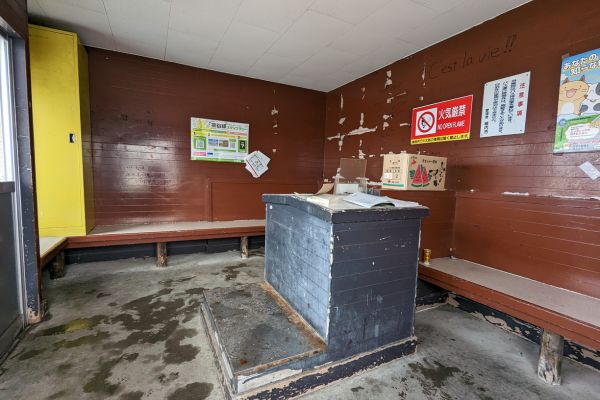
If you’re doing this as a day trip, then keep hold of that paper timetable or photo that the information centre people gave you, and be sure to be waiting outside. Our bus left at 14:55 and we were on it!
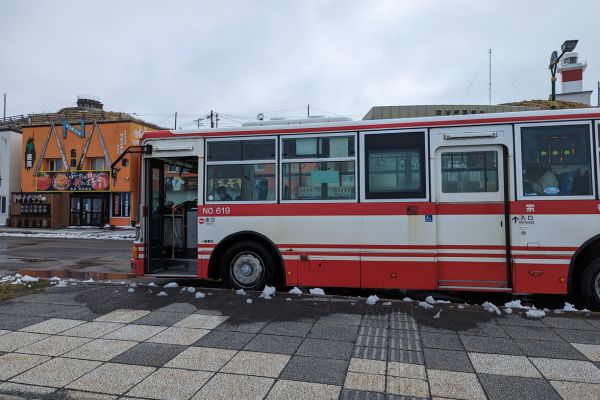
Train from Wakkanai to Sapporo
There’s one train a day back to Sapporo, ours left at 17:40; the timetable may differ slightly, but it will be within about 10 minutes. If you don’t catch this train, then you’ll be staying overnight in Wakkanai. It doesn’t go any faster or slower on the way back to Sapporo, and there’s no catering service on it, so you’ll want to eat before you get on the train, or pick yourself up a bento box from one of the stores in or near the station. The train back to Sapporo takes 5 hours, give or take a few minutes.
What to see in Wakkanai
You’ll have a little time in Wakkanai before you need to be at the JR station to catch the return train to Sapporo. So here are a few things to keep you occupied!
The “Most Northerly Signs” at JR Wakkanai
I mean, you can’t miss the most northerly signs on the train station, and the end of the tracks monument, as well as manhole covers, too.
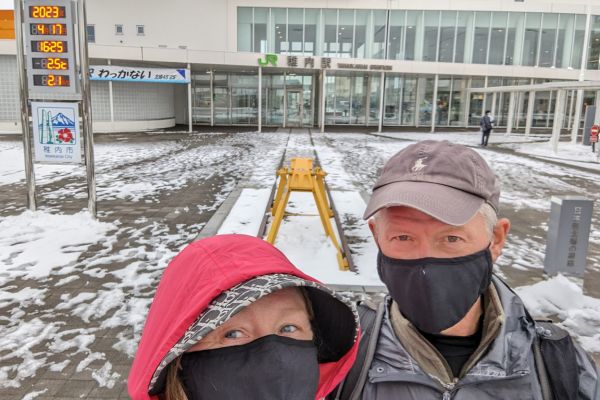
The Wakkanai Breakwater Dome
We headed out to the Breakwater Dome. It’s Wakkanai’s most well-known landmark, and it’s stunning. It was designed on a Roman arcade with 70 columns, but dates from 1936. It’s known as the Breakwater Dome, and you can see why that is from its design. It took us just under 10 minutes to walk there from the JR Wakkanai Station.
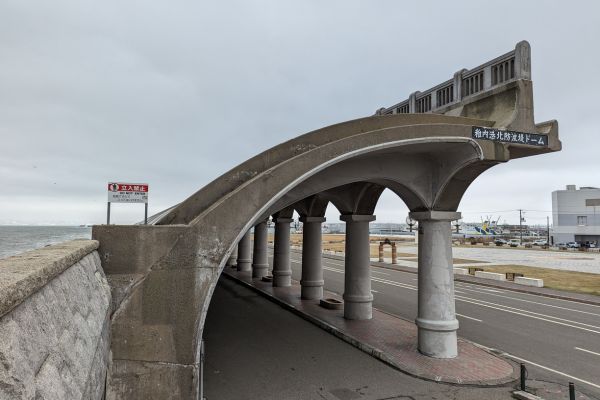
The Wakkanai Karafuto Museum
You’ll find this museum inside the Fukuko Market building. It’s about 14 minutes to walk here from the station. The market is a seafood and souvenir market. The museum details the history of the island of Sakhalin, which was the Japanese territory known as Karafuto until the end of World War II.
The Centennial Memorial Tower
This observation point gives you views over the ocean and the city, but there’s also a museum here dedicated to Mamiya Rinzo, the Japanese explorer, and the history of Wakkanai. It will take 5 minutes to talk here, and then you’ll need to climb the hill too.
The 1978 tower was built to commemorate the 100th anniversary of the founding of Wakkanai. It has an observatory at 70 meters.
The Rishiri Rebun Sarobetsu National Park
A 10-minute walk from the JR station is the ferry terminal, from here you can take boats to Rishiri and Rebun Islands. These islands are known for trekking and alpine flowers.
JAPAN TRAVEL RESOURCES
TRAIN TICKETS
Easiest way to buy train tickets, use Klook for Shinkansen Train Tickets, check timetables & reserve seats.
Book Train Tickets
HOTELS AND APARTMENTS
See choices here
Sea view rooms? Budget rooms? Need a washing machine? The best choice of hotels & apartments.
TOURS & ATTRACTIONS
Most excursion choices, small group tours, skip-line tickets, free cancellation and top local guides.
Top options here.
CAR RENTAL GUIDE
Read my Guide
Best choice of vehicles, automatics, large or small cars, child seats. Book early for more options.
Tips for Taking a Day Trip to Cape Soya
Unless you’re particularly well wrapped up, I wouldn’t take this day trip in the winter months. It was bitterly cold in mid-April, and I think at one point I had 5 layers on. You also won’t see much with snow and ice on the ground and snow or hail in the air.
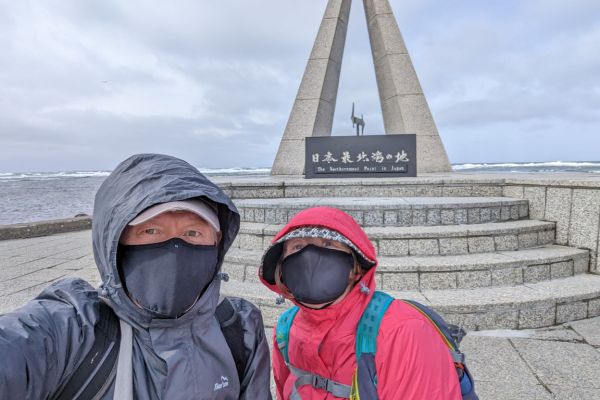
Have a plan for what you’re going to see in, and in what order, at Cape Soya, and keep an eye on the time. If the bus and train combination transport options are your way here, then you’ll need to be back on the bus to catch the train. Otherwise, there are several hotels in Wakkanai, and you’ll have another day at leisure in Wakkanai before returning to Sapporo.
If we’d had longer here, then we’d have also gone to Noshappu Point, from where you can see Rishiri Island, and also Rebun Island. But we don’t. Perhaps next time.
Final Words on Taking a Cape Soya Day Trip from Sapporo
This was a brilliant, if long, day out. Somehow, though long days out in Japan are easy, not least because the trains make it that way and are not at all stressful. It was a great experience to head to Hokkaido’s frozen north. We picnicked in the waiting room at Soya Misaki and ate at Wakkanai before catching the train back south. A brilliant day trip from Sapporo.
ASocialNomad is a participant in the Amazon Services LLC Associates Program, an affiliate advertising program designed to provide a means for sites to earn advertising fees by advertising and linking to amazon.com, amazon.co.uk, and amazon.ca. Amazon and the Amazon logo are trademarks of Amazon.com, Inc. or its affiliates. As an Amazon Associate, I earn from qualifying purchases.
